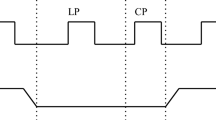Abstract
Timing violations, also known as delay faults, are a major source of defective silicon in modern Integrated Circuits (ICs), designed in Deep Sub-micron (DSM) technologies, making it imperative to perform delay fault testing in these ICs. However, DSM ICs, also suffer from limited controllability and observability, which impedes easy and efficient testing for such ICs. In this paper, we present a novel Design for Testability (DFT) scheme to enhance controllability for delay fault testing. Existing DFT techniques for delay fault testing either have very high overhead, or increase the complexity of test generation significantly. The DFT technique presented in this paper, exploits the characteristics of CMOS circuit family and reduces the problem of delay fault testing of scan based sequential static CMOS circuits to delay fault testing of combinational circuits with complete access to all inputs. The scheme has low overhead, and also provides significant reduction in power dissipation during scan operation.


















Similar content being viewed by others
References
Ahmed N, Ravikumar C, Tehranipoor M, Plusquellic J (2005) At-speed transition fault testing with low speed scan enable. In: VLSI test symposium. IEEE, Piscataway, pp 42–47
Akers SB (1959) On a theory of Boolean functions. J Soc Ind Math 7(4):487–497
Bruni L, Buonanno G, Sciuto D (1992) Transistor stuck-at and delay faults detection in static and dynamic CMOS combinational gates. In: International symposium on circuits and systems. IEEE, Piscataway, pp 431–434
Cao Y, Sato T, Orshansky M, Sylvester D, Hu C (2000) New paradigm of predictive MOSFET and interconnect modelling for early circuit simulation. In: Custom integrated circuits conference. IEEE, Piscataway, pp 201–204
Cheng K-T, Devadas S, Keutzer K (1993) Delay-fault test generation and synthesis for testability under a standard scan design methodology. IEEE Trans Comput-Aided Des Integr Circuits Syst 12(8):1217–1231
Chiang ACL, Reed IS, Banes AV (1972) Path sensitization, partial boolean difference and automated fault diagnosis. IEEE Trans Comput C-21(2):189–195
Dadda L (1965) Some schemes for parallel multipliers. Alta Freq 34:349–356
Dervisoglu BI, Strong GE (1991) Design for testability: using scanPath techniques for path-delay test and measurement. In: International test conference. IEEE, Piscataway, pp 365–374
Eichelberger EB, Williams TW (1977) A logic design structure for design for testability. In: Design automation conference. ACM, New York, pp 462–468
Glover CT, Mercer MR (1988) A method for delay fault test generation. In: Design automation conference. IEEE, Piscataway, pp 90–95
Hansen MC, Yalcin H, Hayes JP (1999) Unveiling the ISCAS-85 benchmarks: a case study in reverse engineering (1999). IEEE Des Test Comput 16(3):72–80
Hesley S, Andrade V, Burd B, Constant G, Correll J, Crowley M, Golden M, Hopkins N, Islam S, Johnson S, Khondker R, Meyer D, Moench J, Partovi H, Posey R, Weber F, Yong J (1999) A 7th-generation x86 microprocessor. In: International solid state circuits conference. IEEE, Piscataway, pp 92–93
Lesser JP, Shedletsky JJ (1980) An experimental delay test generator for LSI logic. IEEE Trans Comput 29(3):235–248
Levendel Y, Menon PR (1986) Transition faults in combinational circuits: input transition test generation and fault simulation. In: International fault tolerant computing symposium. IEEE, Piscataway, pp 278–283
Lin CJ, Reddy SM (1987) On delay fault testing in logic circuit. IEEE Trans Comput-Aided Des 6(5):183–190
Lin X, Press R, Rajski J, Reuter P, Rinderknecht T, Swanson B, Tamarapalli N (2003) High-frequency, at-speed scan testing. IEEE Des Test Comput 20(5):17–25
Malaiya YK, Narayanaswamy R (1984) Modeling and testing for timing Faults in synchronous sequential circuits. IEEE Des Test Comput 1(6):62–74
Mao W, Ciletti MD (1990) Arrangement of latches in scan-path design to improve delay fault coverage. In: International test conference. IEEE, Piscataway, pp 387–393
Mitra S, Seifert N, Zhang M, Shi Q, Kim KS (2005) Robust system design with built-in soft-error resilience. IEEE Comput 38(2):43–52
Mutoh S, Douseki T, Matsuya Y, Aoki T, Shigematsu S, Yamada J (1995) 1-V Power supply high-speed digital ciruit technology with multithreshold-voltage CMOS. IEEE J Solid-State Circuits 30(8):847–853
Rabaey JM, Chandrakasan A, Nikolic B (2002) Digital integrated circuits: a design perspective. Pearson Education, Upper Saddle River
Savir J (1992) Skewed load transition test: part I, calculus. In: International test conference. IEEE, Piscataway, pp 705–713
Savir J (1992) Skewed load transition test: part II, coverage. In: International test conference. IEEE, Piscataway, pp 714–722
Savir J (1994) On broad-side delay test. In: VLSI test symposium. IEEE, Piscataway, pp 284–290
Saxena J, Butler KM, Gatt J, Raghuraman R, Kumar SP, Basu S, Campbell DJ, Berech J (2002) Scan-based transition fault testing - implementation and low cost test challenges. In: International test conference. IEEE, Piscataway, pp 1120–1129
Shepard KL, Narayanan V (1996) Noise in deep submicron digital design. In: International conference on computer-aided design. IEEE, Piscataway, pp 524–531
Synopsis Inc. (2000) Primetime Reference - Version 2000.11. Synopsis, Mountain View
Tekumalla RC, Menon PR (1997) Delay testing with clock control: an alternative to enhanced scan. In: International test conference. IEEE, Piscataway, pp 454–462
Touba NA, McCluskey EJ (1996) Applying two pattern tests usign scan-mapping. In: VLSI test symposium. IEEE, Piscataway, pp 393–397
University of Texas at Austin (2007) EE382M VLSI-2 class notes, http://www.ece.utexas.edu/~mcdermot
University of Texas at Austin (2007) VLSI testing class notes, http://www.ece.utexas.edu/~touba
Wallace C (1964) A suggestion for a fast multiplier. IEEE Trans Comput 13:14–17
Wood TJ (1999) The test and debug features of the AMD-K7TM microprocessor. In: International test conference. IEEE, Piscataway, pp 130–136
Acknowledgments
The authors would like to thank Whitney J. Townsend for helping us design the multipliers. This work was supported in part by the IBM Faculty Partnership Award Program, and in part by the Gigascale Systems Research Center at UC Berkeley under contract 2003-DT-660 from Microelectronics Advanced Research Corporation (MARCO).
Author information
Authors and Affiliations
Corresponding author
Additional information
Responsible Editor: K.-T. Cheng
Antony Sebastine and Ravi Gupta contributed to this paper when they are graduate students at the University of Texas at Austin.
Rights and permissions
About this article
Cite this article
Datta, R., Gupta, R., Sebastine, A. et al. Controllability of Static CMOS Circuits for Timing Characterization. J Electron Test 24, 481–496 (2008). https://doi.org/10.1007/s10836-007-5059-6
Received:
Accepted:
Published:
Issue Date:
DOI: https://doi.org/10.1007/s10836-007-5059-6




